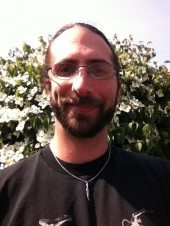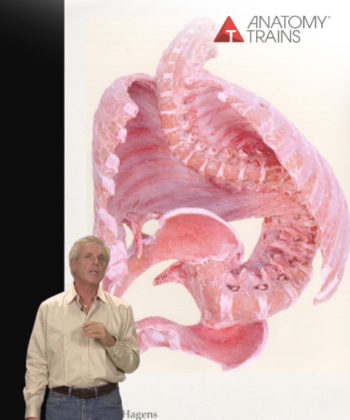An interview with Anatomy Trains certified teacher, Jason Spitalnik. We’re excited to start featuring the important voices of our teachers and students here at Anatomy Trains.
 I went to college for Culinary Arts. Little did I know at the time how important that would be once getting into bodywork. I found that ‘dissecting’ sides of beef, pork, lamb and so on would translate so well to the human body. We really aren’t that much different. I was separating tissue and removing long tough ‘straps’ of connective tissue or silver skin, as chefs call it for 15 years, before I decided to switch professions. Culinary Arts is really tough work with bad and long hours, and once mastered was no longer a challenge for me. I was simultaneously burning out and putting way too many ‘off road’ miles on my body.
I went to college for Culinary Arts. Little did I know at the time how important that would be once getting into bodywork. I found that ‘dissecting’ sides of beef, pork, lamb and so on would translate so well to the human body. We really aren’t that much different. I was separating tissue and removing long tough ‘straps’ of connective tissue or silver skin, as chefs call it for 15 years, before I decided to switch professions. Culinary Arts is really tough work with bad and long hours, and once mastered was no longer a challenge for me. I was simultaneously burning out and putting way too many ‘off road’ miles on my body.
I decided to go into massage, not so much for the massage part but for the interest in anatomy that originated well before working in the kitchen. I remembered my interest in anatomy going back to World Book Encyclopedias, to date myself. My favorite section to flip through and read was the human body section. Some of you might remember the clear cellophane layered images of the human body, I would flip back and forth through those over and over again. Perhaps that is why it was fairly easy for me to retain the anatomical map in my head, once I changed professions.
Once I finished massage school, I found myself asking why. Why are there knots here? Why is there pain here? How can I help this person feel better, beyond Swedish massage? With these questions in mind, one of my teachers at massage school said I should look into neuromuscular therapy. Immediately after massage school I went right into NMT and was certified before I had my Rhode Island massage license in hand. This was the beginning of my pursuit. I still found I still had burning questions. As great as NMT is, I wanted more. A friend of mine from massage school told me next to study with James Waslaski. I did and was able to add a different feather in my cap. This is great work for acute injury rehabilitation. But I still found myself asking, why and how. Why and how do these things / pathologies / itisis happen? James said, ‘if you have the time, read Anatomy Trains.‘ Immediately after reading Anatomy Trains, I knew I had to take the weekend workshop; after the workshop, I knew I needed to take the KMI Structural Integration certification training. The KMI course answered so many of my questions. On the day of graduation I sat down next to Tom (Myers) and asked, “how do I teach for you?” “Just show up,” he said. Over the next 3 years I would train to become a teacher. Now my question has changed to, what else is there? I love teaching this work. The students in my courses teach me with their comments and they ask great questions which sometimes require me to do more research.
I am now immersed in neurofascia, visceral manipulation and cranial sacral work. I find these are three modalities to be very valuable areas that can help a person heal. I also love the biochemistry research involved with collagen. The Fascia Research Congress is most exciting for me. Yes, I am that kind of geek.
At the end of April, I will be in Bethlehem, PA teaching intrinsic muscles of the pelvis. This is a great workshop to help balance your clients’ pelvis.
My two favorite presentations are What Shapes Us? and Fascia. I love the fascia lecture because I love biochemistry. I have been doing research on fascia remodeling for over a year now and hope to soon come out with an article. The shape lecture really brings home the idea that we are not just a mechanical body we are formed by our emotions and experiences. If many people come into the office with the same type of pain, each one of them will have a different cause. Why? Each individuals life experience has been different. Their life is unique only to them. How do they organize around stressors, injuries, surgeries, traumas or whatever and it doesn’t necessarily have to be bad. This way of thinking keeps this work interesting and challenging. You focus on the whole person and who they are, not just the body part that hurts.
( (Editor’s note: similar lectures to the presentations Jason mentions can be found in Tom’s webinar “Embryology of Fascia”)
Recommended
The Science of Bodywork #2: Embryology of Fascia
$125.00Gain a global perspective in this focused yet wide-ranging tour of how we get ‘put together’ biomechanically in the first nine months of our lives. See anatomy, the body, and the fascial system in a fascinating overview designed for the bodyworker or movement trainer. Understand the fascia’s role in physiology as never before with this… Read more
Add to cartI am in the middle of writing an article about the remodeling of connective tissue. There has been so much research on characteristics of connective tissue and fibroblasts but little research on remodeling and the removal of connective tissue when it is no longer required. This article will hopefully shed some light on the research done and spark some more research into the matrix metalloproteinases. (MMPs)
I am currently on the board of a non-profit organization to help incubate farmers and community gardens. There is so much to say here but I will keep it short. Diet is a very important part of human health. Food is the building block / material that makes up our cells. The quality of those materials is very important to maintain good health. The more local, fresh and well managed foods consumed, the more the body will be set up for success. The secondary focus is food security. New England produces only 15% of its own food. As Tom has said, “we are one bad season away from famine.” Our organization along with many other organization want to increase that number to 50% by 2060.
Being a new father most of the books at my bedside are children’s bed time books. When I do have a minute of quiet time and can stay awake, an article is about all I can digest. I am reading through Journal of Bodywork and Movement Therapies and the Fascia Research Congress Yearbook.






